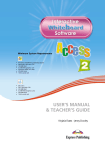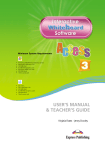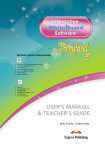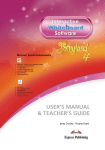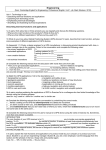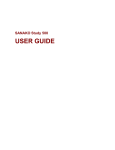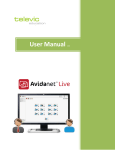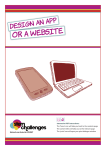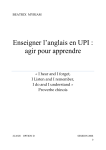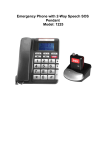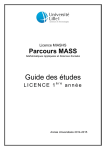Download Virginia Evans - Jenny Dooley
Transcript
Minimum System Requirements ñ ñ ñ ñ ñ ñ ñ Windows 2000/XP/Vista Operating System Pentium® II 400 MHz CPU 128 MB R∞ª 32 MB RAM graphics card QuickTime Player 6 or later CD-ROM drive 16-bit sound card ñ ñ ñ ñ ñ ñ Mac OS X G4 @ 200 MHz CPU 256 MB RAM 32 MB RAM Graphics Card CD-ROM drive 16-bit sound card Virginia Evans - Jenny Dooley Published by Express Publishing Liberty House, New Greenham Park, Newbury, Berkshire RG19 6HW Tel.: (0044) 1635 817 363 Fax: (0044) 1635 817 463 e-mail: [email protected] http://www.expresspublishing.co.uk © Virginia Evans – Jenny Dooley, 2008 First published 2008 Made in EU All rights reserved. No part of this publication may be reproduced, stored in a retrieval system, or transmitted in any form, or by any means, electronic, photocopying, or otherwise, without the prior written permission of the publishers. This book is not meant to be changed in any way. ISBN 978-1-84862-239-5 Part A (User’s Manual) 1. What is an Interactive Whiteboard? ............................................................. 2. What equipment do I need to use the IWB software? ............................ 3. Running the application ........................................................................... On an IBM compatible PC .......................................................................... On a Mac OS .............................................................................................. 4. Navigation ................................................................................................. 5. Task types and how to complete them .................................................... Clicking ...................................................................................................... Clicking and dragging ................................................................................ 6. The toolbar ................................................................................................ 7. The toolbar at a glance ............................................................................. 8. Using the tools .......................................................................................... PC Mode .................................................................................................... Pencil .......................................................................................................... Highlighter ................................................................................................. Create Text Box .......................................................................................... Select Pencil / Highlighter Thickness ........................................................... Select Pencil / Highlighter Colour ................................................................ Zoom .......................................................................................................... Eraser and Eraser Thickness ........................................................................ Hide Part of the Screen .............................................................................. Isolate Part of the Screen ........................................................................... Page Controls ............................................................................................. Print ........................................................................................................... Clear Notes ................................................................................................ Undo / Redo ............................................................................................... Save and Load Notes .................................................................................. Saving Notes .......................................................................................... Loading Notes ........................................................................................ 9. Using Note Exporter on an IBM compatible PC .......................................... Exporting notes .......................................................................................... Importing notes........................................................................................... 10. Using Note Exporter on a Mac OS .............................................................. Exporting notes .......................................................................................... Importing notes........................................................................................... 11. Troubleshooting ........................................................................................ 12. Contact support ........................................................................................ Part B (Teacher’s Guide) ............................................................................. 3 p. p. p. p. p. p. p. p. p. p. p. p. p. p. p. p. p. p. p. p. p. p. p. p. p. p. p. p. p. p. p. p. p. p. p. p. p. p. 4 4 5 5 5 6 11 11 18 19 19 20 20 20 20 20 21 21 21 22 22 23 23 23 23 23 23 24 25 26 27 29 31 32 33 36 36 37 Welcome to Access 1 Interactive Whiteboard (IWB)* software.This application is designed to follow the Access 1 course and enhance your own and your learners’ experience in the language classroom. What is an Interactive Whiteboard? An Interactive Whiteboard is a type of touch-sensitive board, which has the power to transform any classroom into a dynamic learning environment. It allows teachers and students to participate interactively in activities projected onto the board from a data projector which is connected to a computer. Interactive whiteboards are very popular in schools and are considered a more lively and interesting approach than conventional teaching. They provide ways to show students anything which can be presented on a computer (educational software, videos, websites, etc). Research has shown that teaching through interactive whiteboard software has numerous advantages: ñ ñ ñ ñ ñ ñ ñ It It It It It It It can accommodate different learning styles is suitable for both small and larger groups of students helps increase students’ attention span facilitates the assimilation of new information dramatically increases real teaching time reduces the time teachers need for preparation eliminates the need for additional equipment (DVD player, CD player, etc) All in all, it is a powerful teaching tool that will transform your lesson and your classroom! What equipment do I need to use the IWB software? ñ ñ ñ ñ A computer (IBM compatible or Mac OS) A projector An interactive whiteboard or a device that turns a plain whiteboard into an interactive whiteboard Speakers *Note: All the Express Publishing IWB software includes a User’s Manual in PDF format. After the software has run automatically, click the ‘X’ button on the top right corner of the screen to exit. Then go to ‘My computer’, right click on the drive this software is in, and click ‘Explore’. This will open up a window with all components of the software, including the User’s Manual. Double click on the name of the manual to open it. The User’s Manual includes everything the teacher needs to know about using the IWB software. We strongly suggest that the teacher takes some time to familiarise him/herself with the applications (i.e. using the toolbar, task types and how to complete them, etc) on the IWB before proceeding any further. 4 Running the application On an IBM compatible PC The application should run automatically when you insert the CD into your CD drive. If it does not, please follow these steps: 1. Go to START>MY COMPUTER. 2. Locate the icon of your CD drive. With the Access 1 Interactive Whiteboard disk inside your drive, right-click the icon of your CD drive and choose EXPLORE. 3. In the new window that appears, double-click on Access_1.exe. On a Mac OS When you insert the CD into your drive, an icon will appear on your desktop with the name Access_1 (see Fig 1). Fig 1 If you click it, the contents of the CD will appear in a browser window with the following icons and file names (see Fig 2). Fig 2 Click the file to run the application. 5 Navigation By clicking this button you can EXIT the application, at any time. Once the application has run in your system, the first screen you see is the MAIN MENU (see Fig 3). By clicking any of the titles or their numbers, you can enter the corresponding section of the course. All sections that appear in the MAIN MENU lead to SUBMENUS. For example, if you wish to enter Unit 1, Click 1 or School Days (see Fig 3). Fig 3 Once in the MODULE MENU (see Fig 4) you can enter the desired lesson of Unit 1 by clicking the cover page, 1a, 1b, 1c, 1d, 1e or 1f. If you click this button, you can go back to the MAIN MENU at any time. Fig 4 In the LESSON MENU the active tasks you can enter are indicated by a red circle (see Fig 5). Click a task to enter. This allows you the flexibility to skip certain tasks or pick up from where you left off in the previous lesson. This button will take you to the previous menu; in this case, the MODULE 1 MENU. Fig 5 6 Fig 7 Fig 6 These two buttons will take you to the PREVIOUS and NEXT tasks, respectively. Clicking this button SHOWS THE ANSWER(S) to the tasks. For example, Fig 6 shows the screen for Exercise 1, in Lesson 1a. While navigating, you will notice a few more buttons that are designed to help you do the tasks. For instance: Some exercises provide you with the additional option of DELETING THE ANSWER KEY. Clicking this button will allow you to restart the task as many times as you wish. Fig 8 Click this button to PLAY a further extension GAME. 7 Fig 10 Fig 9 Clicking this button will show a screen with the GRAMMAR REFERENCE related to the particular unit and exercise (see Fig 10). Once you have gone through the Grammar Reference, click this button to return to the EXERCISE SCREEN. Clicking this button will activate the ANIMATED PRESENTATION of grammar for the particular exercise (see Fig 11). Click this button to EXIT. Click this arrow to GO TO THE NEXT SCREEN. Fig 11 8 The SONGSHEETS and SELF CHECK sections are organised in a similar way. For instance, if you click to enter the SONGSHEETS section from the MAIN MENU, first you will see the SONGSHEETS MENU (see Fig 12). Clicking any of the song titles or their pictures will take you to that particular song (see Fig 13). Fig 13 Fig 12 Clicking on the PLAY button underneath the lyrics of the song activates the AUDIO. You can click on the PAUSE button at anytime. As each line is sung, it is highlighted in a different colour, to help students follow the correct line as they sing along. You may also find some songs within the lessons (see Fig 14) with the same PLAY and PAUSE controls in each one. Fig 14 9 Fig 15 Fig 16 In a similar manner, if you enter the SELF CHECK section, first you will see the SELF CHECK MENU (see Fig 15). Clicking any of the spreads will take you to the corresponding submenu (see Fig 16). Again, the circled activities are the interactive tasks included in the software. 10 Task types and how to complete them The Access 1 IWB is designed as a teaching aid to be used in conjunction with the coursebook and for this reason the content is identical. However, in order to do the exercises, you will have to carry out two basic computer actions – clicking and clicking and dragging. Here is an overview of the types of tasks in this software and how to do them: Clicking In most exercises click the SHOW KEY buttons to reveal the suggested answers (see Fig 17-18). Fig 18 Fig 17 The buttons shown in Fig 19 are the SHOW KEY buttons. Fig 19 11 Fig 20 Fig 21 Sometimes, clicking on the correct answer will reveal another SHOW KEY button. Clicking that SHOW KEY button reveals the reference in the text (see Fig 20) or further language practice (see Fig 21). Fig 22 In some tasks, clicking the SHOW KEY button reveals a picture, rather than a text (see Fig 22). 12 In some gap-filling tasks, you must click the gap to see the options (see Fig 23). Then, you click the correct answer and it automatically fills the gap in a different colour (see Fig 24). Fig 23 Fig 24 Fig 25 Fig 26 In multiple choice tasks clicking the correct answer may change its colour (see Fig 25), underline it (see Fig 26) or show a tick to indicate its accuracy (see Fig 27). Fig 27 13 Clicking is also used in pronunciation tasks. Click the HEADPHONES next to each item to activate the audio as well as the SHOW KEY button to reveal the answer to the task (see Fig 28). In some tasks, clicking the correct column will reveal a tick (see Fig 29). Fig 28 Fig 29 In listening exercises, there is a simple AUDIO PLAYER (see Fig 30). All its buttons are activated by a click (see Fig 31). Click the numbers of each item to reveal a CLUE. Fig 30 Click and drag the SEEK BAR INDICATOR to locate a specific point in the recording. Click and drag this indicator to the left or right to adjust the VOLUME of the recording. Fig 31 PLAY / PAUSE 14 GO TO THE BEGINNING / END of the recording. You will also notice a TAPESCRIPTS button in listening tasks. This will reveal the tapescript of an audio recording. Fig 32 In Listen, read and check tasks, the tapescripts will be revealed if you click the SHOW KEY button (see Fig 33). Then, additional features may be revealed such as related vocabulary (see Fig 34). Fig 33 Fig 34 15 Similar additional features are added wherever possible (see Fig 35-36). Fig 35 Fig 36 Some tasks include more than one screen. For example, Exercise 5 in Lesson 5b has two screens (see Fig 37-38). Click the curved arrow on the bottom right hand to go to the next/previous screen. Fig 37 Fig 38 16 The Extra activities for weaker classes present similar tasks (see Fig 39-40). Fig 39 Fig 40 Click to exit the extra activity. Click to enter the extra activity. 17 Clicking and dragging Fig 41 Fig 42 Fig 43 Fig 44 To match any item (word, phrase, picture etc) to another, you simply click the item and drag it to your chosen place (see Fig 41-44). If the answer is wrong, it will bounce back to its original position. 18 The toolbar At the bottom of every screen, you will find the Toolbar (see Fig 45-47). Fig 46 Fig 45 If for any reason you wish to hide the toolbar during your lesson, you can do so by clicking the arrow on the left-hand side. To make it reappear, you can click the remaining arrow at the bottom on the right. The toolbar at a glance These little green triangles indicate that there are further options available for this tool. Select pencil / highlighter colour Pencil Create text box Zoom Isolate part of the screen Save notes Print Undo Fig 47 Highlighter PC mode Select pencil / highlighter thickness Eraser and eraser thickness Redo Notes page controls Hide part of the screen 19 Load notes Clear notes Using the tools PC MODE: After you have used one of the tools, click this to regain your normal mouse pointer function. This way you can once again click and click and drag. PENCIL: Click to turn your mouse pointer into a pencil. Now you can make your own notes on every screen provided in this software – a very useful tool if you want to write students’ own answers during prediction warm-up or error correction (see Fig 48). Make sure you select a colour and thickness for your pencil before you actually write anything (see SELECT PENCIL / HIGHLIGHTER THICKNESS and COLOUR). Fig 48 HIGHLIGHTER: Click and drag on every word, phrase or sentence you wish to highlight in a text (see Fig 49). Again, you have the option of selecting the colour and thickness of your highlighter first. Fig 49 CREATE TEXT BOX: If you don’t want to use the pointer/electronic pen of your interactive whiteboard, this is a useful alternative for making notes. Click and drag to create a text box and type in your notes (see Fig 50). Drag the grey bar to MOVE the text box. This is a sample text box: This is the TEXT BOX FORMATTING PANEL. Fig 50 20 Click and drag the arrows to RESIZE the text box. Once you have created a textbox, a formatting panel appears so you can customise your text (see Fig 51). This indicator shows that these colours are applicable to the text. This indicator shows that these colours are applicable to the background. Click a colour for your text. Increase font size by 1 pt with each click. Click a colour for your background. Click to underline your text. Click to make your text bold. Fig 51 Decrease font size by 1 pt with each click. Click to make your background transparent so you can see your notes superimposed on the screen. Click to italicise your text. Click to bullet your text. SELECT PENCIL/HIGHLIGHTER THICKNESS: Once you have clicked this tool, another options panel appears (see Fig 52). Click any of the brush strokes to select the thickness of your pencil or highlighter. Fig 52 SELECT PENCIL/HIGHLIGHTER COLOUR: Click to reveal the colour options panel and select a colour for your pencil / highlighter (see Fig 53). This is a very useful tool if you like to use colour-coding while teaching. Fig 53 ZOOM: Once you have clicked this tool, another options panel appears (see Fig 54). Click this to exit the zoom mode. Click and drag this diagonally over the part of the screen you want to zoom into. Fig 54 21 For example, Fig 55 shows a zoomed in area of a screen. In the bottom right corner, there are four arrows pointing to the top, bottom, left and right. By clicking them individually you can navigate the screen. Fig 55 ERASER and ERASER THICKNESS: When you click this tool, another options panel appears so you can select the thickness of your eraser (see Fig 56). Click the circle of your choice to select the thickness of your eraser and your pointer turns into an eraser. Drag it over the area you wish to erase. If you want to erase a text box, simply click it once and the entire textbox will be deleted. Fig 56 HIDE PART OF THE SCREEN: When you click and drag over a selected area with this tool, you can hide areas such as individual illustrations, paragraphs, words, phrases etc (see Fig 57). This will give you the opportunity to explore tasks and texts further. Fig 57 22 ISOLATE PART OF THE SCREEN: When you click and drag over an area of the screen with this tool, the section you have selected will be visible and therefore focus students’ attention directly on it. The rest of the screen fills up with the colour of your choice (see Fig 58). Fig 58 PAGE CONTROLS: Clicking this tool will reveal another options panel so you can organise your notes in different layers (see Fig 59). Each layer works as a blank page you can write your notes on. This page can be either transparent and visible over the task screen, or opaque and function like a conventional whiteboard. The difference is that now you can prepare your notes before your lesson, or save them after the lesson so as to use them again in the future, with the same class or a different class of the same level. Current page Click to go to the previous page Click to go to the next page Total number of pages Click to make a page opaque Click to make a page transparent Click to add a page Click to delete a page Fig 59 PRINT: Click this to print the screen you are working on, as it is – with notes. Please note that the preferred printing mode for this feature is landscape. CLEAR NOTES: Click this to erase all your notes on a particular screen. UNDO / REDO: Click to undo or redo any action you have just done. SAVE and LOAD NOTES: These two tools are especially useful if you want to use the same notes with another class on a different day. Please note that the Access 1 IWB notes and annotations can be accessed only through this software; therefore, they will be saved in a file created by the software and identified by the software alone. 23 Saving notes First you need to make notes, either using the pencil or the text box tool, as in the example in Fig 60. Fig 60 Then click SAVE . A blue window appears with the options SAVE and CANCEL. Type a name for your notes in the field that appears above these two options and click SAVE. It is best to name your notes according to the unit, exercise, page number and possibly the date you created them (see Fig 61). For example, you could name a file 5a_Ex1_15Dec08. In this way, you can locate them easily once you have accumulated a long list of notes. Fig 61 It is possible that your system will notify you that ‘Local’, i.e. this software, is trying to store a file in your computer (see Fig 62). Click ALLOW. Now you have successfully saved your notes. Fig 62 24 Loading notes Click LOAD NOTES to load a page of notes you have saved. Another blue window appears with the options LOAD and CANCEL (see Fig 63). Click the file name of your notes and then click LOAD. Fig 63 Your saved notes will appear in the same manner as they did when you saved them (see Fig 64). Fig 64 25 Using Note Exporter on an IBM compatible As you save notes while using the Access 1 IWB Software, you may wish to share them with other teachers using this software. You may also wish to use them on a different computer for a different class of the same level. In order to do either, you have to export your saved notes. For this purpose, we have included the Note Exporter utility in this software. Please note that this function is only available for systems that are using the same software and that for Note Exporter to function correctly, you need to have saved at least one set of whiteboard notes. To run Note Exporter go to My Computer. Then, right-click on the icon Access_1 on your disk drive. A drop-down menu will appear (see Fig 65). Click EXPLORE. Fig 65 In the new window that appears, double-click the NoteExporter.exe icon (see Fig 66). Fig 66 Note Exporter will now start. The new window that appears will offer you two options (see Fig 67). Click EXPORT NOTES if you want to transfer notes from this computer to another computer. Click IMPORT NOTES if you want to transfer notes to this computer from another computer. Fig 67 26 Exporting notes N.B.: Before exporting any notes, you will need to have created a folder in your computer into which your notes will be exported. In this example, we have named this folder Access1IWB. When you click EXPORT NOTES the computer will start searching your hard disk for any interactive whiteboard notes that may exist on it. You will see the message in Fig 68. Fig 68 After a few minutes, you will be prompted to enter the application file identifier (see Fig 69). This is the file in which the software saves all your notes. Please type Access1 in the space provided. Please note that this file name is case-sensitive, so it is important that you type it in correctly. Now click OK. Fig 69 A window will appear that asks you to specify the folder in your system where you wish to export your notes. Select the drive and the folder from the drop-down menu and click OK (see Fig 70). Fig 70 27 Please note that, after saving your exported notes on your computer, you may transfer them onto a CD or DVD, a floppy disk or a USB memory stick. Once you have specified where you want your notes to be saved, click OK. You will see the message shown in Fig 71 after a few seconds. Fig 71 The saved notes files have now been moved to the folder that the user specified (see Fig 72). Fig 72 You can rename the file if you wish. However, please DO NOT CHANGE THE FIRST FIVE CHARACTERS (Acc1_) OR THE EXTENSION, as this will make your notes untraceable by the application. You can now store the file(s) you exported on any storage media, or send them by email. When you want to use these files on another computer, use the IMPORT NOTES function. 28 Importing notes To import your exported notes onto another computer that has the same software, run Note Exporter as described in the previous section (see Exporting notes). When you see the window shown in Fig 73, click IMPORT NOTES. Fig 73 The message in Fig 74 will appear: Fig 74 After a few minutes, you will be prompted to enter the application file identifier (see Fig 75). Please type Access1 in the space provided. Again, please remember that this is a set file name and that it is case-sensitive. Now click OK. Fig 75 29 © Express Publishing ∆he message in Fig 76 will appear. Click OK. Fig 76 The next window will ask you to specify the folder in which you have saved the exported notes (see Fig 77). Scroll down the menu and select the folder. Then, click OK. In this particular example, the user has saved their exported notes on their computer in a folder called Access1IWB. However, you can import notes from a CD, DVD, USB stick or any other portable medium. Fig 77 When you have successfully imported the notes, the window in Fig 78 will appear. Fig 78 In order to view the imported notes, you may now load them using the LOAD NOTES function. 30 Using Note Exporter on a Note Exporter operates in a slightly different manner on a Mac Os. To run Note Exporter, insert the disk into your drive. The icon shown in Fig 79 will appear on your desktop. Fig 79 When you click it, the contents of the disk appear in a browser window with the icons and file names shown in Fig 80. Fig 80 Click the icon to run the application. Note Exporter will now start. The new window that appears will offer you two options (see Fig 81). Click EXPORT NOTES if you want to transfer notes from this computer to another computer. Click IMPORT NOTES if you want to transfer notes to this computer from another computer. Fig 81 31 Exporting notes When you click EXPORT NOTES the computer will start searching your hard disk for any interactive whiteboard notes that may exist on it. You will see the message in Fig 82. Fig 82 After a few minutes, you will be prompted to enter the application file identifier (see Fig 83). This is the file in which the software saves all your notes. Please type Access1 in the space provided. Please note that this file name is case-sensitive, so it is important that you type it correctly. Now click OK. Fig 83 A window will appear that asks you to specify the folder in your system from which you wish to export your notes (see Fig 84). Select the drive and the folder from the drop-down menu and click CHOOSE. Fig 84 32 Please note that, after saving your exported notes on your computer, you may transfer them onto a CD or DVD, a floppy disk or a USB memory stick. Once you have specified where you want your notes to be saved, click OK. You will see the message shown in Fig 85 after a few seconds. Fig 85 The saved notes files have now been moved to the folder the user specified. You can rename the file if you wish. However, please DO NOT CHANGE THE FIRST FIVE CHARACTERS (Acc1_) OR THE EXTENSION, as this will make your notes untraceable by the application. You can now store the file(s) you exported on any storage media, or send them by email. When you want to use these files on another computer, use the IMPORT NOTES function. Importing notes To import your exported notes onto another computer that has the same software, run Note Exporter as described in the previous section (see Exporting notes). When you see the window shown in Fig 86, click IMPORT NOTES. Fig 86 The message in Fig 87 will appear: Fig 87 33 After a few minutes, you will be prompted to enter the application file identifier (see Fig 88). Please type Access1 in the space provided. Again, please remember that this is a set file name and that it is case-sensitive. Then click OK. Fig 88 The message in Fig 89 will appear. Click OK. Fig 89 The next window will ask you to specify the folder in which you have saved the exported notes (see Fig 90). Scroll down the menu and select the folder. Please note that you can import notes from a CD, DVD, USB stick or any other portable medium. Click CHOOSE. Fig 90 34 When you have successfully imported the notes, the message in Fig 91 will appear. Fig 91 Again, in order to view the imported notes, you may now load them using the LOAD NOTES function. 35 Troubleshooting Problem Solution I insert the CD in my CD drive but nothing happens. Your computer’s autorun feature is possibly disabled. Go to My Computer and double click on the Access_1 icon. In the new window that opens, double-click on the Access_1 icon. I’ve just written some notes and I want to go back to using the main application, but it seems that I cannot click on anything. Make sure you return to PC Mode using the PC mode icon. Note Exporter cannot find my files. ñ Make sure you have typed the application file identifier correctly. For Access 1 IWB, the file identifier is Access1. ñ If the problem persists, avoid using other applications while running Note Exporter. My pages do not print properly. Make sure your printer is set to print in landscape mode for optimum results. Contact support In case you have any queries on the use of Access 1 IWB, please contact us at [email protected] . 36 A user-friendly Teacher’s Guide on how to use the Access 1 Interactive Whiteboard Software with Access 1. Here are some suggestions on how to approach each section/activity type encountered within the Access course. MODULES ❏ Module presentation page This page is meant to be done mainly using the Student’s Book. The IWB software can be used to facilitate checking answers or having a picture discussion. We suggest you handle each section/activity type in the following way: ñ Activities such as Find the page numbers for …, Describe the pictures, Match the pictures to the words, etc can be done first in the Student’s Book and then checked using the IWB software by clicking on the key button(s). ñ Listen and repeat exercises should be done using the IWB software. Play the recording and invite students to repeat chorally and/or individually. ❏ Reading Lead-in activities There are different types of Lead-in activities such as picture-prompted discussion, short listening extracts, prediction activities, etc. All Lead-in activities should be done using the IWB software. On completion of the activities, teachers can check the students’ answers by activating the key button ( ) to reveal the suggested answers. Reading tasks Reading tasks are to be done using the Student’s Book. The IWB software can be used for listening to the text (if audio is available) and/or for the students to check their answers. Note: Time allowing, we suggest that you do the following extension activities in order to get the full benefit of the applications on the IWB software. Here are some ideas: ñ Words/phrases/sentences, etc can be hidden, using the appropriate tool from the toolbar (See User’s Manual p. 19.), to practise: – vocabulary (i.e. hide the adjectives, nouns, verbs, adverbs, etc), – grammar (i.e. tenses, infinitive, gerund, prepositions, conjunctions, etc) and – comprehension (i.e. what the paragraph is about, summary, etc). ñ Words/phrases/sentences, etc can be underlined/highlighted, using the appropriate tool (See User’s Manual p. 19.), in order for the students to provide questions to statements (e.g. Access 3, Module 2, Unit 2a, Ex. 1 – I heard a loud roar. What did you hear?). Explain the words in bold activities are mainly done using the Student’s Book. First the students offer their own explanations of the words in bold in context and then the teacher reveals the definitions on the IWB software by clicking on them. 37 In cases where the students are unable to offer a definition, the teacher reveals the definition to begin with by clicking on the words in bold and then allows the students some time to make up their own sentence using the word. ❏ Vocabulary The course includes different types of vocabulary activities such as: ñ Look up words/phrases in the Word List. ñ Match words to their synonyms/opposites/definitions, etc. ñ Spidergrams. ñ Gap-filling exercises. ñ Categorising. All the above activities should be done in the Student’s Book and then checked using the IWB software. The IWB software can also be used for revision purposes. If this is the case, the teacher goes through the activities on the IWB with student’s books closed. This is an ideal way to revise vocabulary. Note: In cases where the vocabulary activities are accompanied by an audio extract, the teacher should use the IWB software to play the audio by clicking on the audio player/symbol. These activities are either gap-filling or speaking tasks. In the first case the students should complete the task in their books and report their answers back to the class. The teacher should give feedback to the students through the IWB software. In the second case, the teacher should instigate a discussion in class with the students. He/She can use the suggested answer on the IWB software as a model for the students and keep notes on the board in order to enrich the students’ vocabulary. (For further information see User’s Manual.) As an extension, the teacher can ask the students to write their ideas down before they report back to the class. ❏ Grammar There are different ways of approaching the grammar presentation: ñ If the teacher wishes to do his/her own presentation, he/she can use the appropriate tool from the toolbar (See User’s Manual p. 19.) to open a blank page and present the grammatical structure through his/her own examples. ñ The teacher can refer the students to the grammar reference through the IWB software and present/review the grammar structure, by highlighting, underlining, etc form and usage. ñ For a more stimulating, student-friendly explanation of the grammar structure, the teacher can click on the existing owl symbol and present the grammar with the aid of audio visual prompts. Exploring Grammar: The students work in their books. Then the teacher checks their answers through IWB software. 38 ❏ Listening All listening activities should be done the following way: The students work in their books while the teacher plays the audio through the IWB software. Once the activity is completed, the teacher checks students’ answers through the IWB software. Note: 1 In certain listening tasks such as note taking (listening for specific information), the teacher is advised to go through the gapped text through the IWB software and elicit what kind of information is missing. Then the teacher plays the audio through the IWB software and the students complete the task in their books. 2 All listening tasks in the IWB software are accompanied by a script. This gives the teachers the opportunity to work with the script during the feedback stage. Listen and repeat. All the Listen and repeat activities should be completed using the IWB software. The IWB software provides the teacher with the opportunity to play the audio as many times as is necessary. ❏ Speaking The course includes several types of speaking activities. The students are asked to work on a variety of tasks, some on their own and some in pairs or groups. The students are required to engage in the following activities: ñ conducting an interview ñ performing a dialogue ñ sustaining a monologue (i.e. reporting somebody’s experiences) ñ improvisations using prompts We suggest that all types of speaking tasks should be exploited with the use of the IWB software as follows: ñ First the teacher explains the task and assigns roles. ñ Then the teacher uses the model on the IWB software by activating the key button ( ) in order to elicit ideas/vocabulary, highlight certain key prompts, analyse mind maps, brainstorm for further ideas, etc. ñ Then the students prepare the task as the teacher circulates and monitors the activity. ñ Finally, the students perform the task in front of the class. Note: We advise that all speaking tasks be recorded in order to be included in the Students’ Portfolios. ❏ Everyday English These activities should be completed by the students in their Student’s Books. Then the teacher uses the IWB software to check the students’ answers. ❏ Pronunciation The teacher plays the audio through the IWB software and the students complete the exercises in the Student’s Books. Then the teacher confirms the students’ answers and provides feedback via the IWB software. 39 ❏ Writing/Portfolio We suggest that all writing activities (Portfolio) are approached exclusively by means of the IWB software. First, the teacher works with the students on the plan step by step (i.e. reading through, eliciting answers/ideas, etc). The teacher allows the students some time to make notes. Then the teacher activates the key button ( ) to reveal the model. The teacher, or a student, reads through the model. (The model can be enlarged using the magnifier by clicking on the appropriate tool from the toolbar.) At this stage, the teacher can underline, hide, highlight, etc key phrases on the board and ask the students to replace the phrases with their own ideas. Then the teacher assigns the writing activity as homework. ❏ Projects We suggest that all project work is done through the IWB software. The teacher explains the task and goes through the information required to complete the project. The teacher elicits answers and/or suggestions and conducts a general brainstorming. Then the teacher displays the model on the IWB. He/She can underline, hide, highlight, etc key phrases on the board in order to provide the students with a skeleton for their project work. Finally, the project is assigned as homework. ❏ ICT The ICT sections have been included in order to provide the students with the opportunity for selfaccess. This gives the students responsibility for their own learning and develops their autonomy. For these sections, if the teacher wishes to use the IWB software, we suggest they approach it in the following way: The teacher divides the class into groups and explains the task. He/She displays the model and instigates a class discussion (i.e. picture discussion, what information is included, the way the information is organised, etc). At this stage, the students can take notes. Then the teacher encourages the students to use the Internet in order to obtain the information required to complete their assignment. ❏ Gap-filling exercises The students complete the gap-filling exercises in their Student’s Books. On completion, the teacher checks their answers with the use of IWB software. ❏ Games In some cases the games on the IWB software do not correspond with those in the Student’s Book. We suggest that you work with all of the games through the IWB software. To make the games more fun and competitive, the teacher can divide the class into two teams, A and B. 40 SONGSHEETS The IWB software offers the opportunity to display the lyrics while listening to the audio and also has a karaoke application, so that the students can listen and sing along. We suggest using the IWB software for this purpose and the students can complete the remainder of the tasks in the Student’s Books. SELF CHECK The students complete the Self Check tasks in the Student’s Books. Then the teacher checks their answers through the IWB software. How to approach a module using the IWB software. Below the teachers can find a detailed guide for a selected module from Access 1. 2 Module presentation page (p. 17) ñ Find the page numbers for …: The students work with the Student’s Book and then the teacher checks their answers through the IWB software. ñ Listen and repeat.: This exercise should be done through the IWB software. The teacher plays the audio on the IWB software and the students repeat chorally and/or individually. Then the students translate the words into their own language. Unit 2a Ex. 1 (p. 18) (Student’s Books closed.) This exercise should be done through the IWB software. The teacher refers the students to the picture and the title of the text, and asks them to answer the questions. Then the teacher activates the key buttons to reveal the answers. (Press the forward button to display the second part of exercise 1. ) The teacher invites the students to guess what type of text it is. He/She plays the audio through the IWB software while the students read the text in the Student’s Books. The teacher confirms the students’ answers through the IWB software. Ex. 2 (p. 18) (Student’s Books open.) The students read the text in their Student’s Books and complete the task. The teacher then displays the answers through the IWB software. Extension The teacher hides words/phrases (i.e. Peter Parker, New York City, Mary Jane, strong, fast, Green Goblin, etc.), using the appropriate tool, to provide further reading comprehension practice. Ex. 4 (p. 18) (Student’s Books open.) First the teacher refers the students to the exercise through the IWB software. He/She instigates a discussion about each pair of characters, i.e. their names, 41 their appearance, their character, where they have seen them before, etc. Then the teacher uses the IWB software to check the students’ understanding of the highlighted words by clicking on them to reveal the picture prompts. During this stage, the students match the sentences to the characters. Finally, the teacher allows the students some time to complete the task in the students’ books. Extension The teacher invites the students to use the highlighted words in sentences to describe any other cartoon characters of their choice. Ex. 5 (p. 19) (Student’s Books open.) The students work in the Student’s Books. They go through the grammar theory box and complete the task. The teacher checks their answers through the IWB software. Note: Should teachers wish to provide a more detailed analysis/presentation of the grammar structure, please refer to the Grammar section on p. 39. Ex. 6 (p. 19) (Student’s Books open.) The students complete the task in the Student’s Books. The teacher then checks their answers through the IWB software. Note: Should the teacher feel that the students require further reinforcement, he/she can refer them to the grammar table/reference. Ex. 7 (p. 19) (Student’s Books open.) The students complete the task in the Student’s Books. The teacher then checks their answers through the IWB software. Note: Should the teacher feel that the students require further reinforcement, he/she can refer them to the grammar table/reference. Unit 2b Ex. 1 (p. 20) (Student’s Books closed.) The teacher plays the audio through the IWB software and the students listen and repeat chorally and/or individually. Then the teacher elicits the words that sound similar in the students’ language. Ex. 2a (p. 20) (Student’s Books open.) The teacher plays the audio through the IWB software while the students look in their Student’s Books. Then the teacher checks their answers through the IWB software. Ex. 4 (p. 20) (Student’s Books open.) The teacher goes through the instructions through the IWB software and explains the task. He/She refers the students to the role-play guide through the IWB software and invites the students to make suggestions for each exchange. The teacher then divides the class into pairs and assigns roles. He/She allows the students some time to prepare their role-play and then invites each pair to perform their dialogue in front of the class. During this stage, the teacher can use the suggested answer on the IWB in order to give the students any further assistance. Note: The students can record themselves and file their recording in their Portfolios. Ex. 5 (p. 21) (Student’s Books open.) The students complete the task in their Student’s Books while the teacher plays the audio through the IWB software. Finally, the students report back and the teacher confirms their answers through the IWB software. Note: The script is provided through the IWB software so that the teacher can do further work should he/she wish. 42 Ex. 6 (p. 21) (Student’s Books open.) The students work in the Student’s Books. They go through the grammar theory box and complete the task. The teacher checks their answers through the IWB software. Note: Should teachers wish to provide a more detailed analysis/presentation of the grammar structure, please refer to the Grammar section on p. 39. Ex. 7 (p. 21) (Student’s Books open.) The teacher plays the audio through the IWB software while the students complete the task in their Student’s Books. Then the teacher verifies the students’ answers and provides feedback via the IWB software. Note: Should teachers wish to provide a more detailed analysis/presentation of the grammar structure, please refer to the Grammar section on p. 39. Ex. 8a/b (p. 21) (Student’s Books open.) The students work in the Student’s Books. They go through the grammar theory box and complete the tasks. The teacher checks their answers through the IWB software. Note: Should teachers wish to provide a more detailed analysis/presentation of the grammar structure, please refer to the Grammar section on p. 39. Ex. 10 (p. 21) (Student’s Books closed.) The teacher refers the students to the task through the IWB software. The teacher brainstorms for ideas and can use the suggested answer for further assistance. The task can then be assigned as classwork or homework. Unit 2c Ex. 1 (p. 22) (Student’s Books open.) The students complete the task in the Student’s Books. Then the teacher plays the audio through the IWB software in order for the students to check their answers. He/She confirms their answers through the IWB software. Finally, the teacher asks the students to say what nationality they are. Ex. 3 (p. 22) (Student’s Books open.) The students complete the reading task in the Student’s Books. The teacher confirms the students’ answers through the IWB software. Then he/she refers the students to the Learning to Learn box and elicits the correct answers through the IWB software. The teacher allows the students some time to complete the task in the Student’s Book. Extension With the use of the appropriate tool on the IWB software, the teacher hides certain punctuation marks and invites the students to rewrite the text, selecting the correct punctuation. Ex. 4 (p. 22) (Student’s Books closed.) The teacher refers the students to the exercise on the IWB. He/She elicits answers to the questions given and allows the students some time to make notes. Then the teacher clicks on the button to reveal the model. He/She hides some key words/ phrases (i.e. name, age, nationality, type of collection, etc) and the students complete the gaps. Alternatively, the teacher can highlight or underline the parts in the email that need to be substituted. Then the writing activity is assigned as homework. 43 Unit 2d Ex. 1 (p. 23) (Student’s Books open.) The students complete the task in the Student’s Books. The teacher verifies the students’ answers through the IWB software. Ex. 2 (p. 23) (Student’s Books open.) The students read the text in the Student’s Books while the teacher plays the audio through the IWB software. Then the students report back to the class and the teacher confirms their answers through the IWB software. Ex. 4 (p. 23) (Student’s Books closed.) The teacher explains the task and goes through the information required to complete the project through the IWB software. He/She conducts a general brainstorming about what kinds of souvenirs are available in their country. Then the teacher displays the model on the IWB. He/She can underline, hide, highlight, etc key phrases on the board in order to provide the students with ideas for their project work. Finally, the project is assigned as homework. Unit 2e Ex. 1a (p. 24) (Student’s Books closed.) The teacher plays the audio through the IWB software and invites the students to listen and repeat chorally and/or individually. He/She then asks the students in which situation they would be likely to hear these phrases. Ex. 1b (p. 24) (Student’s Books open.) The teacher reads the sentences through the IWB software and invites the students to guess who says each of them. Then the students read the dialogue in their Student’s Book while listening to the audio through the IWB software in order to check their answers. Finally, the teacher provides the key by clicking on the appropriate button(s) through the IWB software. Ex. 2a (p. 24) (Student’s Books open.) The students complete the tasks in the Student’s Books. Then the teacher uses the IWB software to check the students’ answers. Ex. 3 (p. 24) (Student’s Books open.) The teacher goes through the instructions through the IWB software and explains the task. He/She refers the students to the role-play guide by clicking the appropriate button through the IWB software and invites the students to make suggestions for each exchange. The teacher then divides the class into pairs and assigns roles. He/She allows the students some time to prepare their role-play and then invites each pair to perform their dialogue in front of the class. During this stage, the teacher uses the suggested answer in order to give the students any further assistance. Note: The students can record themselves and file their recording in their Portfolios. Ex. 5 (p. 24) (Student’s Books closed.) The teacher plays the audio through the IWB software. The students listen and repeat chorally and/or individually. Then the teacher asks the students if they can think of other words with the same sounds and he/she verifies their answers through the IWB software. 44 Unit 2f Ex. 1 (p. 25) (Student’s Books closed.) The teacher invites the students to look at the map and the pictures through the IWB software. He/She elicits answers and verifies the students’ answers through the IWB software. Ex. 2 (p. 25) (Student’s Books closed.) This exercise should be done through the IWB software. The teacher asks the students to look at the pictures and complete the task. Extension The teacher invites the students to name other cities in the English-speaking countries. Ex. 3 (p. 25) (Student’s Books closed.) The teacher presents the task through the IWB software. He/She divides the class into pairs and allows the students some time to prepare their exchanges. Then each pair performs their exchanges in front of the class. The teacher verifies their answers through the IWB software. Ex. 4 (p. 25) (Student’s Books closed.) The teacher divides the class into groups and explains the task. He/She displays the model and brainstorms for additional European countries and their capitals. Then the teacher encourages the students to use the Internet in order to obtain the information required to complete their assignment. 45 Access 1 is an English course designed exclusively for students studying English at Beginner Level. The course follows the principles of the Council of Europe Common Framework of Reference Level A1. Student’s CD ook Grammar B Workbook ok Student’s Bo Class CDs Teacher’s Resource Pack (Worksheets, Pairwork Activities, Portfolio Activities, Games & Tests) ) k (interleaved Teacher’s Boo Interactive Whiteboard Software USER’S MANUAL & TEACHER’S GUIDE ISBN 978-1-84862-239-5 9 7 81 84 8 6 22 39 5
















































